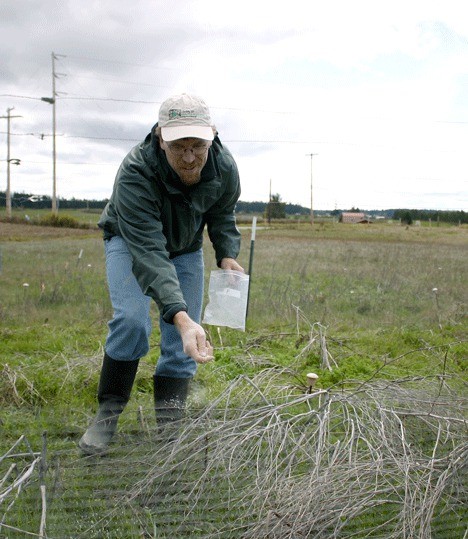A conservation group hopes a county fund will help provide the money needed to pay for continued protection of native grasslands located near Outlying Field on Central Whidbey Island.
The Pacific Rim Institute for Environmental Stewardship is one of three groups applying for Island County’s Conservation Futures Funds. Institute officials want $400,000 to help pay for 175 acres of property owned by the Au Sable Institute, a Christian-based organization for environmental education.
Conservation Futures are funded by property taxes earmarked for preservation and public access projects. There is $735,000 available in 2010.
Holly Kress, resource development officer for the Pacific Rim Institute, said the purchase would allow researchers to continue their work restoring and protecting the prairie.
“We thought it was a really good fit,” Kress said of the Conservation Futures Fund. “It will have a lot of benefits.”
The Au Sable property is noteworthy because it is one of two remaining native prairie remnants left on Whidbey Island.
The status of the property became uncertain in late 2008 when the Michigan-based Au Sable Institute decided to cancel all classes at its Whidbey Island campus, effectively closing the facility. Since then, officials at the campus have been working to form a separate organization that will continue classes and prairie restoration work.
Kress said Au Sable agreed to sell the property to the Pacific Rim Institute for approximately $500,000; considerably lower than the assessed value of $1.9 million. If the Pacific Rim Institute doesn’t raise the money, then it would be placed on the open market, according to the application for Conservation Futures Funds.
Researchers are still working on the property and several college classes are scheduled for the summer.
Kress said a U.S. Department of Agriculture grant is funding restoration work eliminating remnants of a state pheasant farm that once operated on the property. Researchers are removing fences and other remaining debris while planting Roemer’s fescue and hedge rows and installing raptor perches. In another project, researchers from the University of Washington are examining how types of fertilizer and animal interaction affect grassland growth.
Several community workshop classes are planned. Students at Coupeville Middle School are participating in prairie building efforts.
If the Pacific Rim Institute receives enough money to purchase the land, then officials will hash out a conservation easement to add another layer of protection for the prairie. The property is currently zoned as a Special Review District, which basically outlines the possible uses for the land. However, Kress said it would be difficult, but not impossible, for a developer to change the zoning of the acreage. She added that Pacific Rim Institute staff members are talking with officials from the Navy and the Whidbey Camano Land Trust about a possible conservation easement.
Two other entities are also vying for a piece of Conservation Futures Funds.
The Whidbey Camano Land Trust wants $250,000 to help pay for acquiring the conservation easement on 288 acres of farmland. The Land Trust is working with nine landowners to preserve 101 acres located south of Coupeville and up to 187 acres located on the north side of Penn Cove.
Chris Hilton, land acquisition specialist for the Whidbey Camano Land Trust, said the farmland preservation project is valued at $4 million. The Land Trust is seeking $1.7 million from the Natural Resource Conservation Service and $2 million from the state farmland preservation program.
The Greenbank Farm Management Group and the Port of Coupeville are asking for $400,000 to place a conservation easement on the Greenbank Farm. That money would be doled out in $50,000 increments for the next eight years, letting the port off the hook for further land payments.
The three projects are currently going through a review process. Representatives from all three groups presented their plans to a technical advisory group earlier in the week. Then, by the end of April, the projects will go before a community advisory board.
Ultimately, it’s up to the Island County Commissioners to make a decision about which proposals to fund. That decision will likely be made sometime next fall.



